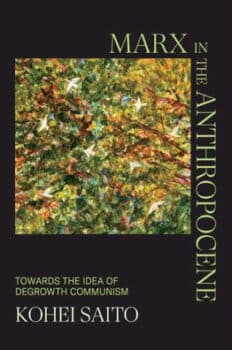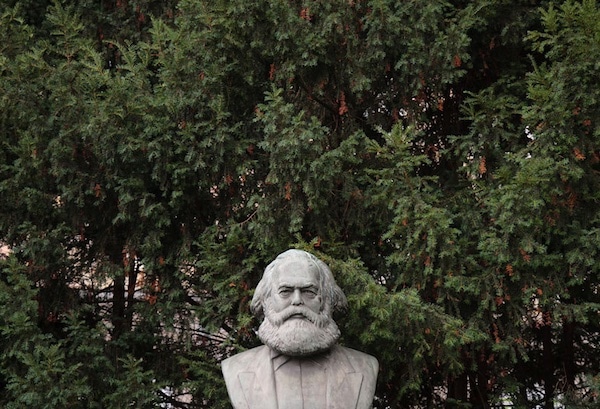
Kohei Saito
Marx in the Anthropocene: Towards the Idea of Degrowth Communism
Cambridge University Press, Cambridge, 2023. 276 pp., $22.99 pb
ISBN 9781009366182
In 2017, Japanese Marx scholar Kohei Saito published Karl Marx’s Ecosocialism, which won the Isaac Deutscher Memorial Prize the following year. It is a study of Marx’s notebooks after the publication of Capital: Volume I, detailing his inquiries into the natural sciences. Saito demonstrated that they constituted not mere distractions to the project of Capital, but a fundamental rethinking of Marx’s critique of capitalism. In those notebooks, Marx abandoned his growth-oriented and techno-optimistic views about communism while investigating the environmental unsustainability of industrial capitalism. If the capitalist mode of production leads to resource depletion, soil exhaustion and the destruction of livable environments, then communist revolution cannot be a mere working-class takeover of the means of production. The production system itself has to be redesigned from scratch.
Marx in the Anthropocene continues this line of inquiry, but moves from scholarly Marx exegesis to a theoretical confrontation with other strands of contemporary Marxist scholarship. Saito links his approach to John Bellamy Foster’s metabolic rift theory from the 2000s and defends it against, among others, post-humanist theories of the Anthropocene (Latour, Moore), Marxist social constructivism (Smith, Castree) and prophecies about fully automated communism (Bastani, Srnicek). Though these polemics excel in their creative use of Marx’s complex and esoteric conceptual experimentations (Saito is less successful in painting an honest picture of the aforementioned opponents), let us focus on Saito’s own position.
Saito’s starting point is volumes I and III of Capital, where Marx worries that industrial, urbanized capitalism and large-scale agriculture disrupt ‘the metabolic interaction (Stoffwechsel) between man and the Earth’ (25). Saito convincingly argues that these sparse references are symptoms of a larger shift in Marx’s thought, evinced in other, previously unpublished work. Marx’s notebooks show that the references to metabolism are part of a larger ecological critique of capitalism.
Nature is, for Marx, not a passive material substratum for human action but a dynamic ecosystem, in which multiple species and substances generate rich living environments. Humankind, however, is unique in this metabolic network of nature insofar as it deliberately reflects on its interactions with its environment and reflexively gives social form to these exchanges with nature. Human society consciously coordinates the labor process, the moment when human activity and natural reality meet, rather than simply left to instinct. This coordination process requires constant adjustments between the social metabolism of human communities and the natural metabolism of their living environments. The dynamics of social and natural processes must align in order to foster stable forms of life.
Capitalism, however, generates misalignments, or ‘metabolic rifts’. The capitalist valorization cycle subsumes both human and non-human beings in pursuit of profit, but ignores the underlying metabolic equilibria of nature. Both workers and nature have to serve the particular purpose of profit-maximization, independently of their own flourishing or subsistence. Whatever fails to enhance economic value production is ejected as waste. The social metabolism of capitalism hence clashes with the metabolism of nature, resulting in pollution, soil exhaustion, biodiversity losses, etc. Capital subsumes nature under a social form that stretches the elasticity of nature beyond its limits, until the elastic band inevitably snaps. Capitalist expansion thereby undermines its own conditions of possibility. Saito’s version of metabolic rift theory thereby masterfully shows how nature can be a dynamic and open-ended agent, and yet still confront humankind with insuperable biophysical limits.
According to Saito, this ecological critique of capitalism and the limits to growth leads Marx to change his perspective on communism after 1868. In these final years, ‘Marx ultimately became a degrowth communist’ (173). However, Saito acknowledges the opposition between the green and red branches of the left, and is aware of the controversy that a term like ‘degrowth communism’ will spark. Yet he convincingly detects some strategic points of convergence: environmental movements are turning away from ‘green capitalism’ and seem increasingly open to revolutionary activism, while socialists have largely abandoned the Stakhanovite promise of proletarian redemption through work and have become more critical of Promethean techno-solutionism. Anti-capitalist environmentalism and post-work socialism converge into degrowth communism.
In his post-1868 notebooks and correspondence, Marx turns to the study of natural scientists and ethnologists who focus on how non-Western, rural communities organized their economies around collective and commons-based use-value production. These communities sustained economic systems that might not grow exponentially, but also did not create metabolic rifts with their natural environments. They were de facto stationary economies run through the collective ownership over the means of production. In earlier years, Marx would have dismissed these examples as isolated relics from a primitive past doomed to be soon integrated into global capitalism. This Marx would have argued that pre-capitalist communities must first assimilate to capitalism and thoroughly industrialize before they can make the jump to communism.
The later Marx, however, upholds a multilinear understanding of historical materialism. The general laws of capitalism always interact with very specific local conditions. They consequently generate variegated trajectories of historical development. The road to socialism can hence vary for different societies. Especially in the case of Russia, Marx regarded the Narodniks’ rural communes as active sites of resistance against capitalism. He praised the communes’ alignment of social and natural metabolisms: these communities had successfully fostered sustainable interaction between economic and ecological processes. They had created a social system that interacted with nature not to maximize capital accumulation, but in order to optimally satisfy the collective needs of their members. They had thereby achieved economic abundance not by technologically enhancing the productive apparatus, but by harmonizing people’s needs and nature’s fecundity through a commons-based agricultural regime.
Marx is not a romantic advocate for returning to subsistence farming, but he speculates about what those in the West can learn from these agrarian communities. He argues that they should mimic elements from the social form of these communes’ production process in order to overcome capitalist metabolic rifts. Capitalism subsumes everything under a strict valorization process that incessantly ousts exhausted nature and surplus populations. The alternative focuses on the production of use-values governed in common without putting excessive strains on the environment. These examples point to a future where the sustainable, free and full development of human potential reigns.
Marx in the Anthropocene provides an original and engaging reformulation of Marx’s thought that not only demonstrates the relevance of even Marx’s most obscure writings, but also uses these texts to formulate a poignant critique of capitalism that unites environmentalist and socialist concerns. The book’s ability to articulate a common critical framework for both movements is its main achievement. That is no easy project given the decades-long heated debates between socialists and degrowth activists. But to keep both camps satisfied, Saito’s ultimate depiction of degrowth communist politics remains underdetermined. The book ends with a programmatic list of demands, like an investment shift toward sectors that promote of use-values instead of economic value (e.g. education, healthcare, or the arts), reducing the workday, enhancing workplace democracy and restraining technologies that dispossess workers from the power to coordinate their own labor. These general policy-suggestions are open-ended enough to simultaneously accommodate red and green demands, but also not terribly specific. In this programmatic vagueness lies this reviewer’s main criticism to Saito’s book.
Marx in the Anthropocene excels at diagnosing the objective contradictions of the logic of capital vis-à-vis the metabolism of nature. The depiction of how the general tendential structures of capitalism clash with the needs of nature’s metabolic processes is impressive in its insight and presentation. However, this theory of the objective contradictions of capitalism in the abstract does not link up to a concrete conjunctural analysis of today’s ecological struggles. We get a general exploration of the logic of capital and its limits, but not of the political power dynamics and divergent subject-positions of the current moment, nor of how these power-relations can be leveraged for a better future. As Saito himself claims, the general laws of capitalism interact with particular local environments with variegated effects. Degrowth communism must consider these localized variations in order to efficaciously articulate its politics. While, for example, the overworked cognitariat of the Global North might cheer for a reduction of the workday, informal workers in the Global South have had only limited access to governmentally regulated labor-time in the first place. While indigenous populations might rejoice at a movement that respects ancestral claims to their land and opposition to industrialization, the working class of the Global North – a net beneficiary of the ecological exploitation of the Global South – would mainly perceive degrowth communism as an enforced limitation on its ability to drive polluting cars, go on holiday abroad or eat meat. To make degrowth communism work as a political strategy, these variable subject-positions and their divergent social demands must be ideologically aligned.
As a political strategy, degrowth communism cannot solely rely on the objective logic of capital and its metabolic rifts to lead people to a better future. It must also work on the libidinal economies of the oppressed in order to render a non-growth, commons-based economy a desirable and shared vision of a post-capitalist future. If people are expected to experience degrowth as a form of radical abundance rather than painful asceticism, the libidinal metabolism of their desires must also change, which is a blind spot in Saito’s current framework. Saito has thereby expertly shown what is at stake in the struggle for an ecologically sustainable future, but the ideological work of writing a degrowth communist manifesto is yet to be completed.

